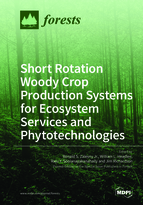Short Rotation Woody Crop Production Systems for Ecosystem Services and Phytotechnologies
A special issue of Forests (ISSN 1999-4907). This special issue belongs to the section "Forest Ecology and Management".
Deadline for manuscript submissions: closed (15 May 2019) | Viewed by 66685
Special Issue Editors
Interests: bioenergy; biomass; ecophysiology; ecosystem services; forest genetics; intensive forestry; phytotechnologies; short rotation woody crops
Special Issues, Collections and Topics in MDPI journals
2. Arkansas Forest Resources Center, University of Arkansas Division of Agriculture, 110 University Court Monticello, AR 71656, USA
Interests: the effects of genotype, environment, and management on tree/forest growth, physical structure, and utilization by livestock and wildlife
Interests: poplar and willow genetic improvement, agroforestry, ecophysiology, production of bioenergy crops on marginal lands and phytoremediation
Special Issue Information
Dear Colleagues,
Historically, international efforts in the development of short rotation woody crops (SRWCs) focused on the production of biomass for bioenergy, biofuels, and bioproducts, while research and deployment over the past decade has expanded to include broader objectives of achieving multiple ecosystem services. In particular, silvicultural prescriptions developed for SRWCs have been refined to include woody crop production systems for environmental benefits, such as carbon sequestration, water quality and quantity, and soil health. In addition, current systems have been expanded beyond traditional fiber production to other environmental technologies that incorporate SRWCs as vital components for phytotechnologies, urban afforestation, ecological restoration, and mine reclamation. In this Special Issue, we explore the broad range of current research dedicated to international “Short Rotation Woody Crop Production Systems for Ecosystem Services and Phytotechnologies”.
Dr. Ronald S. Zalesny, Jr.
Dr. William L. Headlee
Dr. Raju Y. Soolanayakanahally
Mr. Jim Richardson
Guest Editors
Keywords
- biomass
- carbon
- forest restoration
- mine reclamation
- phytoremediation
- soils
- urban afforestation
- water







